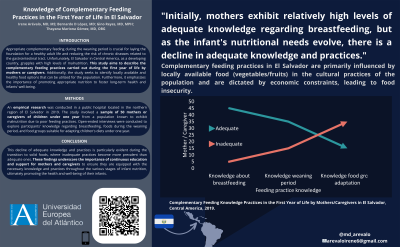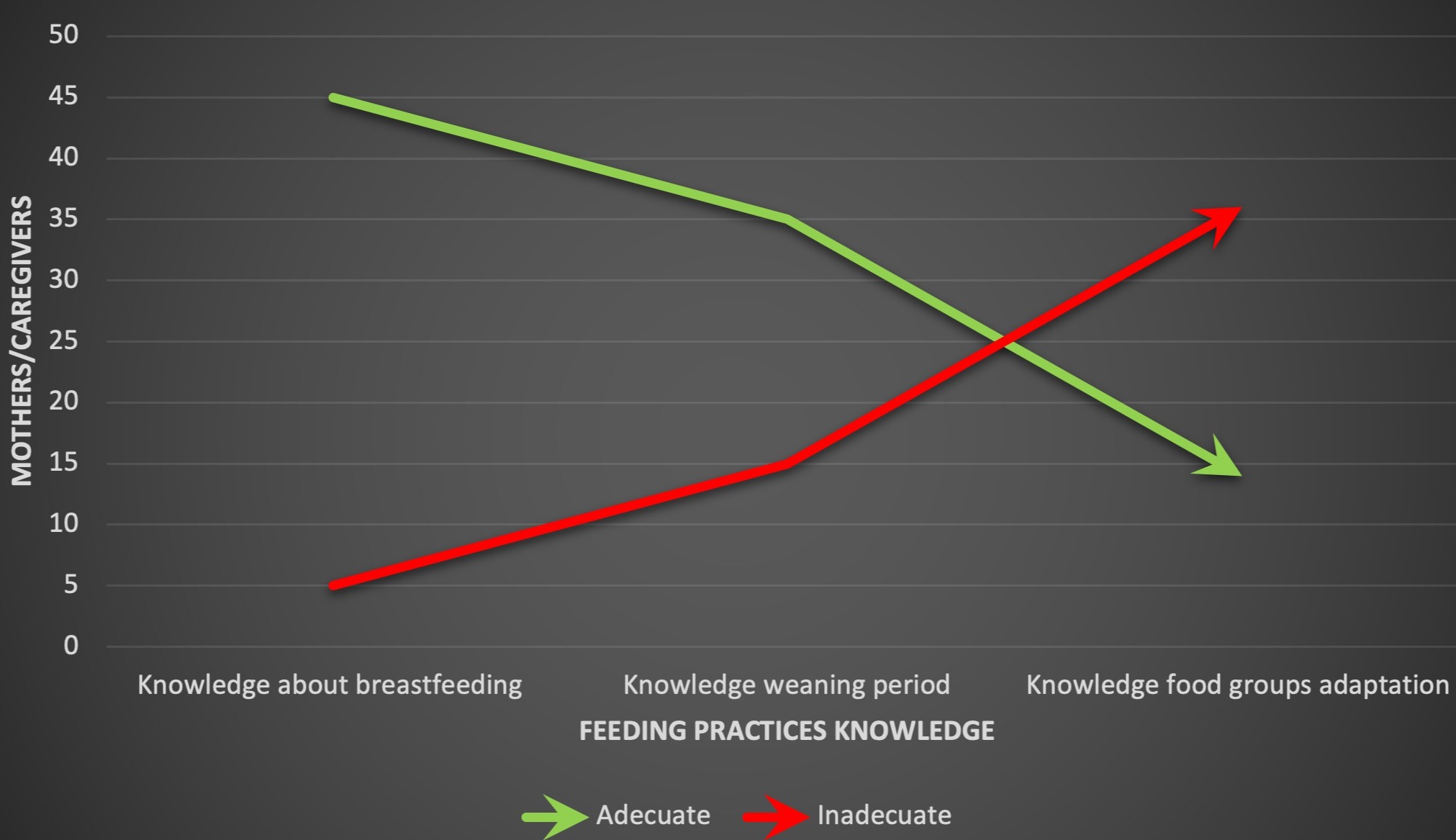Sunday Poster Session
Category: Pediatrics
P1176 - Knowledge of Complementary Feeding Practices in the First Year of Life in El Salvador, Central America
Sunday, October 22, 2023
3:30 PM - 7:00 PM PT
Location: Exhibit Hall

Has Audio

Bernardo Lopez Samayoa, MD
Johns Hopkins Bloomberg School of Public Health
San Bernardino, CA
Presenting Author(s)
Irene Maria Guadalupe Arevalo Soto, MD, MSc1, Bernardo Donery Lopez Samayoa, MD2, Ingrid Thayana Mariona Gómez, MD3, Gino Smith Reyes Aguilera, MD, MPH4
1Universidad Europea del Atlantico, Los Angeles, CA; 2Johns Hopkins Bloomberg School of Public Health, San Bernardino, CA; 3Universidad de El Salvador, Los Angeles, CA; 4Universidad de El Salvador, Northridge, CA
Introduction: Appropriate complementary feeding during the weaning period is crucial for laying the foundation for healthy adult life and reducing the risk of chronic diseases related to the gastrointestinal tract. Unfortunately, El Salvador in Central America, as a developing country, grapples with high levels of malnutrition. This study aims to describe the complementary feeding practices carried out during the first year of life by mothers or caregivers. Additionally, the study seeks to identify locally available and healthy food options that can be utilized for the population. Furthermore, it emphasizes the importance of promoting appropriate nutrition to foster long-term health and infants' well-being.
Methods: Empirical research was conducted in a public hospital located in the northern region of El Salvador in 2019. The study involved a sample of 50 mothers or caregivers of children under one year from a population known to exhibit malnutrition due to poor feeding practices. Open-ended interviews were conducted to explore participants' knowledge regarding breastfeeding, foods during the weaning period, and food groups suitable for adapting children's diets under one year.
Results: See Graph 1.
Discussion: Although 90% of mothers/caregivers agree that breastfeeding is the leading food in the first month of life, this knowledge gradually decreases when weaning begins. However, there were variations in perceptions regarding when breastfeeding should end and when to initiate the introduction of solid foods into the infant's diet. While 70% of respondents suggested that breastfeeding should begin at six months, others suggested different ages. This finding may indicate the need to provide more education and support to mothers/caregivers about this critical aspect of infant nutrition.
Complementary feeding practices in El Salvador are primarily influenced by locally available food (vegetables/fruits) in the cultural practices of the population and are dictated by economic constraints, leading to food insecurity. Currently, iterative barriers exist in practical guidance implemented by the Ministry of Public Health to support health professionals in offering adequate guidance to mothers/caregivers during preventive check-ups in primary care health centers.

Disclosures:
Irene Maria Guadalupe Arevalo Soto, MD, MSc1, Bernardo Donery Lopez Samayoa, MD2, Ingrid Thayana Mariona Gómez, MD3, Gino Smith Reyes Aguilera, MD, MPH4. P1176 - Knowledge of Complementary Feeding Practices in the First Year of Life in El Salvador, Central America, ACG 2023 Annual Scientific Meeting Abstracts. Vancouver, BC, Canada: American College of Gastroenterology.
1Universidad Europea del Atlantico, Los Angeles, CA; 2Johns Hopkins Bloomberg School of Public Health, San Bernardino, CA; 3Universidad de El Salvador, Los Angeles, CA; 4Universidad de El Salvador, Northridge, CA
Introduction: Appropriate complementary feeding during the weaning period is crucial for laying the foundation for healthy adult life and reducing the risk of chronic diseases related to the gastrointestinal tract. Unfortunately, El Salvador in Central America, as a developing country, grapples with high levels of malnutrition. This study aims to describe the complementary feeding practices carried out during the first year of life by mothers or caregivers. Additionally, the study seeks to identify locally available and healthy food options that can be utilized for the population. Furthermore, it emphasizes the importance of promoting appropriate nutrition to foster long-term health and infants' well-being.
Methods: Empirical research was conducted in a public hospital located in the northern region of El Salvador in 2019. The study involved a sample of 50 mothers or caregivers of children under one year from a population known to exhibit malnutrition due to poor feeding practices. Open-ended interviews were conducted to explore participants' knowledge regarding breastfeeding, foods during the weaning period, and food groups suitable for adapting children's diets under one year.
Results: See Graph 1.
Discussion: Although 90% of mothers/caregivers agree that breastfeeding is the leading food in the first month of life, this knowledge gradually decreases when weaning begins. However, there were variations in perceptions regarding when breastfeeding should end and when to initiate the introduction of solid foods into the infant's diet. While 70% of respondents suggested that breastfeeding should begin at six months, others suggested different ages. This finding may indicate the need to provide more education and support to mothers/caregivers about this critical aspect of infant nutrition.
Complementary feeding practices in El Salvador are primarily influenced by locally available food (vegetables/fruits) in the cultural practices of the population and are dictated by economic constraints, leading to food insecurity. Currently, iterative barriers exist in practical guidance implemented by the Ministry of Public Health to support health professionals in offering adequate guidance to mothers/caregivers during preventive check-ups in primary care health centers.

Figure: Complementary Feeding Knowledge Practices in the First Year of Life by Mothers/Caregivers in El Salvador, Central America.
Disclosures:
Irene Maria Guadalupe Arevalo Soto indicated no relevant financial relationships.
Bernardo Donery Lopez Samayoa indicated no relevant financial relationships.
Ingrid Thayana Mariona Gómez indicated no relevant financial relationships.
Gino Smith Reyes Aguilera indicated no relevant financial relationships.
Irene Maria Guadalupe Arevalo Soto, MD, MSc1, Bernardo Donery Lopez Samayoa, MD2, Ingrid Thayana Mariona Gómez, MD3, Gino Smith Reyes Aguilera, MD, MPH4. P1176 - Knowledge of Complementary Feeding Practices in the First Year of Life in El Salvador, Central America, ACG 2023 Annual Scientific Meeting Abstracts. Vancouver, BC, Canada: American College of Gastroenterology.
